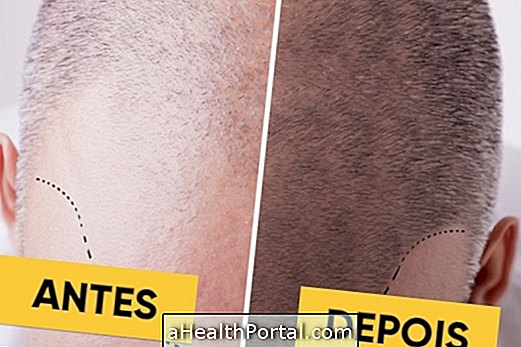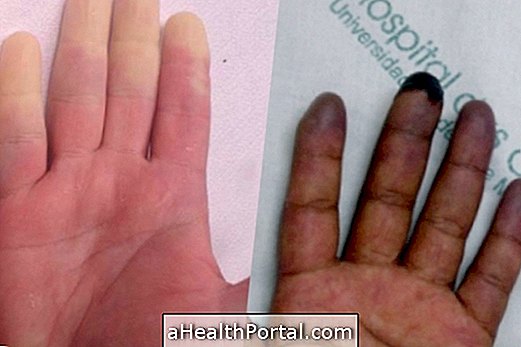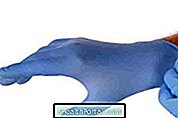The capillary schedule is a type of intensive moisturizing treatment that can be done at home or in the beauty salon being particularly suitable for people with damaged or curly hair who want beautiful and perfectly hydrated hair without having to resort to chemicals, and without becoming a slave to permanent, straightening, brushing and plank.
This schedule lasts for 1 month and at the end of the first week you can notice a big difference in the before and after the hair, because it gets much softer, hydrated and shiny, even the day after hydration, nutrition or reconstruction.

How to make
To follow this capillary schedule you should wash and moisturize the hair 3 times a week, taking the following care in each wash:
Stage 1: When the hair is badly damaged
| Week 1 | Hydration | Nutrition | Reconstruction or Cauterization |
| Week 2 | Nutrition | Hydration | Nutrition |
| Week 3 | Hydration | Nutrition | Reconstruction or Cauterization |
| Week 4 | Hydration | Hydration | Nutrition |
Stage 2: When hair is poorly damaged
| Week 1 | Hydration | Nutrition or Humidification | Hydration |
| Week 2 | Hydration | Hydration | Nutrition or Humidification |
| Week 3 | Hydration | Nutrition or Humidification | Hydration |
| Week 4 | Hydration | Nutrition or Humidification | Reconstruction or Cauterization |
For maintenance: when hair is healthy
| Week 1 | Hydration | Hydration | Nutrition or Humidification |
| Week 2 | Hydration | Nutrition or Humidification | Hydration |
| Week 3 | Hydration | Hydration | Nutrition or Humidification |
| Week 4 | Hydration | Nutrition or Humidification | Reconstruction or Cauterization |

How to do Hydration
Moisturizing serves to return the moisture from the threads, and therefore the most indicated masks are those containing ingredients such as: fruit, chocolate, honey, plant extract or panthenol.
- Examples of products: These are the moisturizing masks that can be found in supermarkets and can be used for 3 minutes during bathing, for example.
Moisturizing is responsible for maintaining the natural water of the hair and the best way to ensure this moisturizing is to use a shampoo suitable for your hair type and do not need to use conditioning, applying the mask just after washing.
How to do Nutrition
The nutrition serves to restore the natural oils of the threads, and the most indicated products are those containing oils or butters in their composition. Thus, the label of the masks may contain the words: nourishing, nutrition, butter treat or repair. Here, vegetable oils can also be used for wetting.
- Examples of products: They are easily found in supermarkets and generally have names such as deep moisturizing mask with avocado oil, or coconut oil, or in the case of containing butters may be written: deep moisturizing mask with cocoa butter or shea butter, for example. Adding a little coconut oil to your moisturizing mask is also a great way to make good nutrition.
Nutrition is part of the schedule that restores the natural fat present in the hair, which leaves the hair without frizz, without volume, double tips and with great brightness.
How To Make Reconstruction
The reconstruction serves to replenish proteins, amino acids and keratin in hair strands. In this case, the most indicated products should contain ingredients such as keratin, collagen or amino acids. Thus, in products should contain the words: rebuilder, mass repositor, repair, rebuild, strenght.
- Examples of products: Usually found in cosmetic stores, or the internet, but hypermarkets may also have some keratin options, for example.
Reconstruction or cauterization should only be done every 15 days, or at least once a month, on all types of hair. It will replace the capillary mass and is therefore indicated when it presents the thin, brittle and opaque yarns, the main objective being to strengthen the yarn.
How Long to Make the Capillary Schedule
The capillary schedule can be carried out for up to 6 months, and it is possible to stop for 1 month, where it is necessary to use shampoo, conditioning and combing cream, if necessary, and then return to the schedule. Some people have no need to stop the schedule because the hair does not get heavy or oily. If this happens it may be necessary to change the products and a hairdresser can indicate in which phase your hair is and what the schedule is most suitable for your needs.
Ideally, the hydration schedule should be kept for long periods because it is the best way to keep your hair beautiful and hydrated, with no frizz or double ends. A good indication that the treatment is working is not feeling the need to cut hair, not even the tips.

When results can be seen
Usually in the first month of the hair schedule you can notice a good difference in hair, which is much more beautiful, hydrated and without frizz. However, when hair is badly damaged due to the use of chemicals such as progressive, relaxation or permanent, the best results can be seen in the second month of treatment.
Those who are going through the hair transition and no longer want to straighten the hair artificially can take 6 to 8 months to get your hair completely hydrated and with good definition of the curls without having to resort to chemicals. But this is only possible if beyond the schedule, there are daily care with the wires.
How to make my own capillary schedule

It is possible to create your own hair schedule according to what your hair needs. A good way to know if your hair needs moisturizing, nourishing or rebuilding is by testing the porosity of the yarn by putting a strand of hair inside a glass with water. If the wire floats, it needs hydration, if it stays in the middle means it needs nutrition and if sinking needs rebuilding.

























